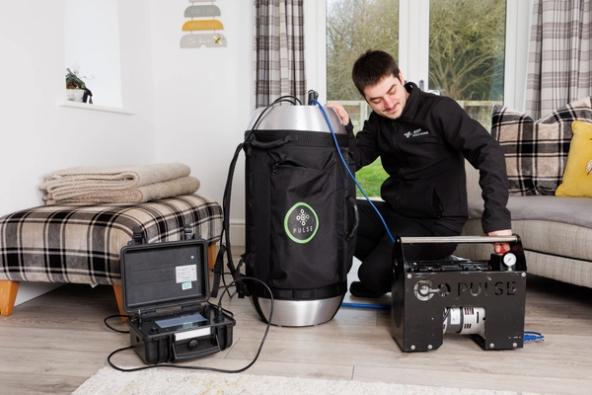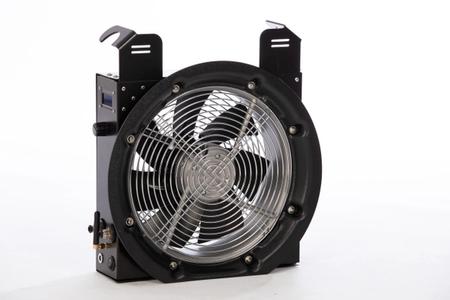Technical
PAS 2035 - Different Types of Air Tightness Tests
PAS 2035 is the new specification document that covers the 'whole-house' or 'whole building' retrofitting of domestic buildings and includes provisions for air tightness testing.

Under Section 8.5: Assessment of the PAS 2035 retrofit standard, an airtightness test may be required to test the air permeability of the building envelope, using an approved method, including identification of key leakage locations.
It is only mandatory for Path C risk levels, however, PAS 2035 additionally states that testing of the air permeability of the building envelope may be useful irrespective of the assessed level of risk, and should be carried out at the discretion of the Retrofit Coordinator.
When is an airtightness test required for PAS 2035?
Airtightness is the measured airflow through a building at a pressure of 50 pascals (pa). This is known as the Q50.
PAS 2035 states:
If the post-retrofit is better or expected to be better (less) than 5m³/hr/m² then continuous running ventilation such as Mechanical Ventilation with Heat Recovery (MVHR) also called Heat Recovery Ventilation or Mechanical Extract Ventilation (MEV) is recommended.
If post-retrofit Q50 is worse (i.e. the building is leakier) than 5m³/hr/m², trickle vents with intermittent or passive ventilation are permitted.
There is a specific requirement for the air tightness testing of Path C (high risk) retrofit projects but there is also a strong argument for testing both pre and post-retrofit in respect of all pathways.
The magical figure of 5m³/hr/m² can be checked very quickly and easily prior to any works being carried out. Undertaken early along the specification timeline an airtightness test can help define the measures that may or may not be appropriate hence driving potential efficiencies.
A pre and post-works test can act as quality assurance against the installed energy efficiency measures (EEMs) and also to confirm the final Q50.
PAS 2035 airtightness test methods
There are two main types of air tightness tests – both of which are approved under PAS 2035.
Compare Pulse and Blower Door air tightness testing methods
Pulse air permeability measurement system is an approved testing method under PAS 2035
PAS 2035 Blower Door Test
The traditional Blower Door Test: A blower door kit consists of a variable speed fan attached to a frame and a flexible panel designed to fit across an external doorway.
The fan can work in two ways – it can either suck the air out of the property hence lowering the internal air pressure. In this case, the higher external air pressure will flow in through all unintended ventilation points (gaps, cracks etc) and a digital pressure gauge connected to a manometer (to measure airflow) will record the pressure differences inside and outside the home and hence calculate the Q50.
The system can also work in reverse if deemed more appropriate. In this situation, the fan is used to increase the internal air pressure and the pressure loss is recorded.
PAS 2035 Pulse Test
Pulse Air Permeability Measurement System represents a new way of air tightness testing which is fully approved under PAS 2035 (and also new-build under Part L).
The Pulse measurement kit consists of a cylindrical air receiver, a control box and a portable compressor. It’s portable, clean, modern-looking, minimally intrusive and non-disruptive to residents.
Rather than having to mount across a door opening Pulse sits on the floor anywhere around the centre of the property.
The compressor pressurises the air in the receiver which, once fully pressurised, then releases several short pulses of air which create a temporary increase in air pressure enabling air leakage to be quickly and accurately measured by the system and recorded onto the control box.
It works at a low (near ambient) pressure level of just 4Pa thus minimising the impact on the property and, by measuring at a lower pressure, the system provides an air change rate measurement that is representative of normal inhabited conditions, helping to improve understanding of energy performance and true building ventilation needs.
Whilst it may take a few minutes to pressurise the air receiver the actual test is over in under 2 minutes. The result is instantly visible on the control box and the test data can then be downloaded from the unit and uploaded to the free reporting website where a full report can be generated and saved.
Occupants may remain in the building for the duration of testing and the test does not penetrate the envelope and will not change the temperature of the building.
Along with supplying the equipment BTS can provide full user training or can connect you with third party accredited organisations who can also provide this training.
Airtightness Test Preparation
Regardless of the air tightness testing method used, prior to testing the property needs to be prepared as follows:
- All external windows and doors should be closed and properly latched/engaged.
- All internal doors should be opened and remain open during the test.
- All devices taking air from or rejecting air to the outside should be turned off
- All-purpose provided ventilation should be temporarily sealed e.g. intermittent fans, cooker extractor grill, mechanical ventilation supply/extract points, passive through-the-wall vents, chimneys, open flues etc.
- Drainage traps in toilets, sinks, showers and wet rooms should be filled with water




